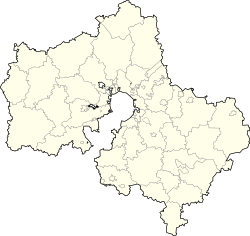Zvenigorod
| Zvenigorod (English) Звенигород (Russian) |
|
|---|---|
| - Town - | |
 The Moskva River in Zvenigorod |
|
 Location of Moscow Oblast in Russia |
|
|
|
|
|
|
|
| Administrative status (as of January 2013) | |
| Country | Russia |
| Federal subject | Moscow Oblast |
| Administratively subordinated to | Zvenigorod Town Under Oblast Jurisdiction |
| Administrative center of | Zvenigorod Town Under Oblast Jurisdiction |
| Municipal status (as of February 2010) | |
| Urban okrug | Zvenigorod Urban Okrug |
| Administrative center of | Zvenigorod Urban Okrug |
| Statistics | |
| Area | 48.1 km2 (18.6 sq mi) |
| Population (2010 Census) | 16,395 inhabitants |
| Density | 341/km2 (880/sq mi) |
| Time zone | MSK (UTC+03:00) |
| First mentioned | 1338 |
| Town status since | 1784 |
| Dialing code(s) | +7 49869 |
| on | |
Zvenigorod (Russian: Звени́город) is an old town in Moscow Oblast, Russia. Population: 16,395 (2010 Census);12,155 (2002 Census);15,805 (1989 Census).
The community has existed since the 12th century, although its first written mention is dated 1338. The town's name is based either on a personal name (cf. Zvenislav, Zvenimir) or on a hydronym (cf. the Zvinech, Zvinyaka, Zveniga Rivers); the derivation from "town of ringing (bells)" is a folk etymology.
Zvenigorod rose to prominence in the late 14th century after it was bequeathed by Dmitry Donskoy to his second son Yuri, who founded his residence on the steep bank of the Moskva River. The local kremlin, called Gorodok, contains the only fully preserved example of 14th-century Muscovite architecture, the Assumption Cathedral (1399) (Cathedral of the Dormition of the Holy Virgin Mary; in Russian: Успенский собор на Городке). The cathedral's interior features frescoes by Andrei Rublev.
Zvenigorod is primarily remembered for internecine wars waged by Yuri's sons for control of Moscow during the reign of their cousin Vasily II (1425–1462). After their party was defeated, the town was incorporated into the Grand Duchy of Moscow.
Zvenigorod was granted town rights in 1784. By the late 19th century, the town gained popularity among the intelligentsia as a fashionable banlieue of Moscow. Many extravagant dachas were built in the neighbourhood. Some of these house museums of Sergey Taneyev, Anton Chekhov, and Isaac Levitan.
...
Wikipedia

